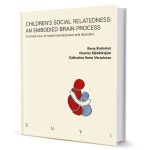
Children’s social relatedness: an embodied brain process
A clinical view of typical development and disorders
The subject of this book is the infant’s and young child’s social relatedness, including together the relationship between attachment and theory of body, speech-language, and theory-of-mind function, as well as the disorders that can occur.
Authors: Barış Korkmaz, Charles Njiokiktjien, Catharina Anna Verschoor
Hard cover, 888 pages, 5000 references (not in book, on bookshop.suyi.nl), 45 figures, 51 tables, 10 drawings
ISBN 978 90 72008-12-1
€ 48.00
€ 10.00 (PDF)
Order this book online at Suyi Bookshop.
Also available in pdf format.
![]()
——
The authors have sought to integrate the developmental neurosciences and bring them closer to the people who diagnose and treat children with contact, communication and social-relatedness disorders. They are convinced that a developmental neurobiological approach together with careful clinical examination and knowledge of current findings in neuropsychology are indispensable. It has become clear that child psychiatrists and neurologists, as well as child neuropsychologists and psychotherapists, need information about the relationship between brain and behaviour in a practical clinical context.
Barış Korkmaz is a professor of adult and child neurology specialized in autism, language disabilities and developmental disorders. He had some postgraduate training in the Department of Child Life and Health at the Royal Hospital for Sick Children, Edinburgh. He studied autism and developmental disorders with child neurologist Isabelle Rapin at the Yeshiva University’s Albert Einstein School of Medicine in New York City, and made observations in the neuropsychology laboratory and Child Study Center of the Psychiatry Department, Washington University in Seattle. He currently teaches in the Division of Child Neurology of the Department of Neurology, Cerrahpaşa Medical Faculty, Istanbul, Turkey.
Charles Njiokiktjien specialized in neurology and psychiatry in Amsterdam and wrote a doctoral thesis on equilibrium physiology, which he studied with Dr. Jean-Bernard Baron in Paris. He studied developmental neurology with Professors Heinz Prechtl and Bert Touwen in Groningen, the Netherlands; special education and child neuropsychiatry with the late Professor Frits Grewel in Amsterdam; and child aphasiology with child neurologist Isabelle Rapin in New York City. He is currently a consultant at the Developmental Dysphasia Foundation in Amsterdam, the Netherlands.
Catharina Anna Verschoor is a clinical psychologist and occupational therapist. She has participated in developmental neuropsychological studies. She currently practices child neuropsychology and is team coordinator at the Developmental Dysphasia Foundation in Amsterdam, the Netherlands. The three authors’ focus of interest is developmental psychology, neurology and neuropsychoanalysis.
Contents
Foreword
Introduction
Chapter Part I: Brain development in ontogeny
1 Brain development and plasticity before and after birth
2 Neural bases of cognitive functions
3 Behavioural genetics
4 Models of abnormal brain function and developmental disorders
Part II: Infant and toddler
5 Nature, diversity and principles of ontogenetic processes
6 Early relatedness: attachment and theory of body
7 Development of expressive praxis and gestural dyspraxia
8 Tan’s metamorphosis concept of speech-language development and early deviancy
9 Autism spectrum disorders, early signs
Part III: From toddler into school age
10 Development of theory of mind
11 Autism spectrum disorders, late signs
12 Developmental dysphasia, late signs
Part IV: Treatment principles
13 Treatment principles for developmental disorders
References
Glossary and abbreviations
